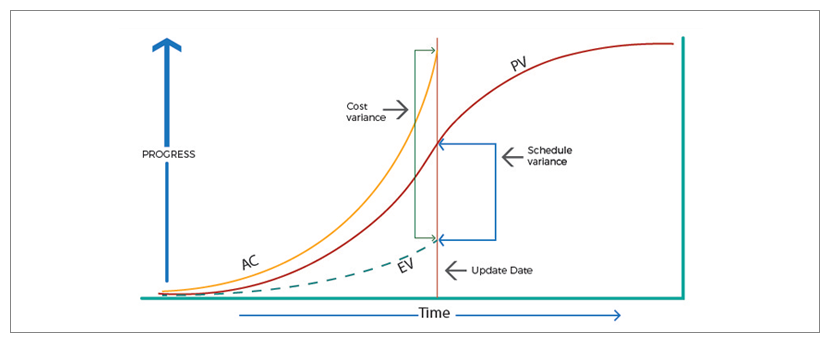As a project manager, you must be familiar with situations when your projects unexpectedly sit in the grey area between success and failure. Sometimes, your project stays within the budget but overshot the timeline. It can adhere to the timeline but at the price of a high burnout rate in other circumstances. Despite planning meticulously, the lack of performance tracking against variables like cost and time contributes to project failure. So, if you are looking for more definitive goals for success, here is some good news.
Earned Value Management or EVM helps you see clearly ‘where a project stands’ and ‘how far is the journey ahead.’ This accuracy helps spot discrepancies, change plans, correct mistakes, and makes timely yet quality delivery possible.
EVM brings cost and time – two diverse yet crucial factors on a unified scale and lets you compare the execution against planned. It brings you closer to precision in project planning and accuracy in performance for unmatched process delivery. It empowers you to define responsibilities without burning out your team members and, at the same time, provide stakeholders the clarity in terms of the progress.

This article will cover the essential aspects of EVM. So, before delving deep, let’s begin with the definition of earned value management.
What is “Earned Value Management”?
Earned Value Management system helps managers systematically measure project performance against the project baseline. It integrates schedule, costs, and scope to compare the planned vs. actual and identify the variances if any.
EVM helps project managers to spot discrepancies and rectify them for timely delivery within budget. It also helps in forecasting, enabling project managers to adjust accordingly.
Earned Value Management Concepts and KPI’s
Going by the basic principle of EVM, the value of work is equal to the costs budgeted to complete it. Earned Value Management systems has three data sources, namely:
- Planned Value (PV): The estimated value of work scheduled to complete within a stipulated time
- Earned value (EV): The approved budget for the work completed by the specified date.
- Actual Cost (AC): The actual expenses incurred for the work completed by the designated date.
Analyze your project’s schedule and cost performances with EVM based on the following crucial indicators:
- Schedule variance (SV): The difference between the actual work done against the estimates. It indicates if the project is on schedule or not with the formula SV = EV – PV. 0 variance means the project is on schedule. Negative or Positive variance means it is behind and ahead of schedule, respectively.
- Cost variance (CV): It is the difference between Earned Value EV and the Actual Cost AC. It shows if the project is within budget or not using the formula CV = EV – AC. 0 variance means the project is adhering to the approved cost. Negative and positive variance indicates the project is going over and under the budget, respectively.
- Schedule performance index (SPI): The ratio between the Earned Value EV and Planned Value PV. It is a relative measure of the project’s time efficiency using the formula SPI = EV/PV. If the value of SPI is greater or equal to 1, it means the project is on track. Less than 1 indicates a deviation from the scheduled budget.
- Cost performance index (CPI): It is the ratio of Earned Value (EV) to Actual Costs (AC). The CPI is equal to the earned value divided by the actual costs, CPI = EV / AC.” It is a relative measure of the project’s cost efficiency and can estimate the remaining task’s cost. PMI’s PMBOK® Guide defines the CPI as a “measure of cost efficiency on a project.”
Importance of Earned Value Management
Earned value analysis is a project management technique for evaluating how a project performs against its budget and schedule. It helps derive an estimate of the resources needed to complete the project. Comparing the work finished to the forecast made at the beginning of the project, the project manager can predict how many resources are needed for completion.
Unlike the Elapsed Time that fails to provide an accurate measure of project completion, Earned Value offers an objective measurement of the work accomplished. Let’s illustrate with an example.
For example, if a 12- monthly construction project includes tasks such as engineering, plumbing, and electrical, one would assign values such as:
Engineering – 55%
Plumbing – 20%
Electrical – 25%
When each task finishes, its Value is added to your EV. In this example, if you completed engineering and plumbing at the six-month milestone, you can report that you have utilized 50% of the time and you have 75% EV. Thus with EVM, budgeting and scheduling are in time-phased, planned value increments, which eventually form a Performance Measurement Baseline.
Benefits of Earned Value Management
Let us look at some of the essential advantages of using EVM.
Helps in realistic project planning:
To reap the benefits of EVM, project managers must spend a considerable amount of time determining a reasonable budget and a realistic time frame. While chalking out the project plan from start to finish and distributing work across your team, managers need to account for potential challenges. Adding EVM to the planning process entails defining the project baseline, including schedule, cost, and scope.
Managers can use this baseline as a reference point to assess project performance over time. EVM provides a clear picture of where your project stands versus where it should have been as planned. It also shows the actual work completed against the projected schedule. Thus, EVM provides actionable insights that help project managers determine if the initial plan was realistic and act proactively.
Gain real-time visibility of centralized information
To track project performance in real-time, the project manager needs to have complete visibility across the enterprise. EVM is instrumental in helping managers track performance metrics on robust management tools. It integrates schedules and budget into the system and using Gantt charts it provides actionable insights on reports and analytics. Thus, earned value management helps gauge progress at every step and milestone.
Using the objectivity of time and costs, you can assign small yet measurable chunks of work to your teams and pick up the pace. Project managers are notified in case of deviation to take necessary proactive steps to bring the project back on track. Once the project execution begins, EVM also helps point our inaccuracies based on task dependency priorities.
Measure schedule and budget accuracies
Surprises can come at any point during the project life cycle. There can be changes in project scope, client priorities, and unforeseen roadblocks such as the COVID 19 pandemic. Accordingly, the schedule and budget might deviate from the project plan. What happens when you realize after completing 80% of the project that you exhausted the budget but managed to stick to deadlines?
To avoid such partial failures, you can calculate and implement schedule variances SC and cost variances CV as mentioned above. Measuring these variances at every milestone helps mitigate damages. It also helps to take precautionary measures to bring the CV level to zero.

Source: PMI
Anticipate risks and intervene early
As part of the EVM process, project stakeholders are alerted to problem areas that can put the project at risk throughout its life cycle. It enables them to make adjustments ahead of time to prevent the project deviate from the original plan. Some of these modifications include tweaking project scope and budgets, procuring more resources, investing in better technologies, and more.
It also helps you avoid the recurrence of the same problems that impede progress. Earned value management helps identify problems when they occur. It also allows anticipating the risks associated with the project budget and schedule. Accordingly, managers can intervene and take early actions before experiencing any setbacks.
Enhances accountability and motivation
As earned value analysis provides better clarity and control on the activities involved, it enables project managers to respond to issues early. As a part of EVM, employees need to track their time and report their progress against the baseline. It motivates top performers to keep up the extra effort and encourages the ones lagging in picking up the pace and match their coworkers’ output.
Performance indexes like SPI and CPI, as mentioned above, shows if your project is within the budget and proposed timeline. For example, knowing 50% of the project is completed will keep them motivated and look forward to the product launch. During portfolio analysis, this clarity helps stakeholders assess which projects have a higher likelihood of being successful.
The Takeaway:
Drawing from the points mentioned above, EVM helps you objectively measure the work completed on a project at any given point and take necessary actions in case of a deviation. However, it might be worth reiterating that without the right project management process, tools, and willingness to change, organizations cannot reap the benefits of EVM. For starters, you can experiment with the EVM regime on one or two tasks before including it as a part of your routine project management process.












